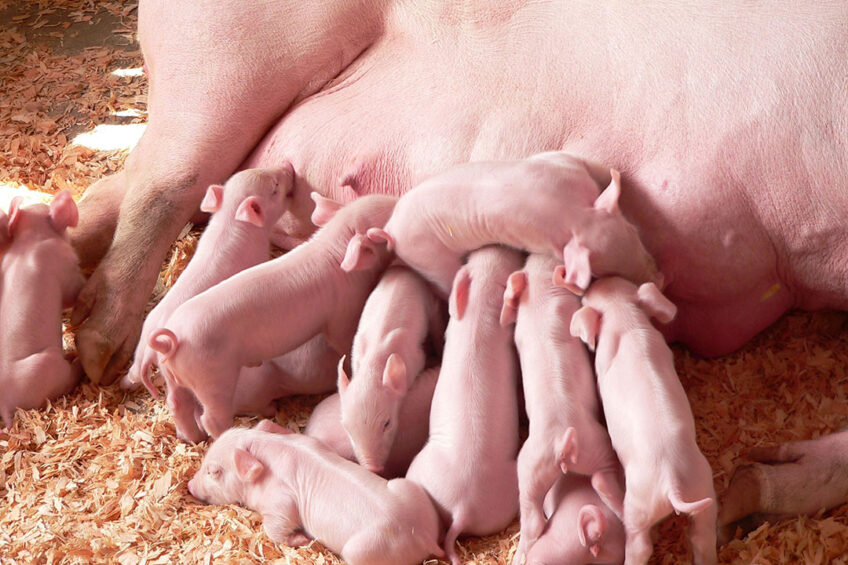Formulating diets to minimise weight loss in lactating sows

Farrowing and lactation cause severe metabolic changes in sows. The lactation phase increases sow energy requirements and since the sow prioritises her litter nutrient requirements above her own body, it will result in significant mobilisation of body reserves if she doesn’t receive the proper amount of nutrients in her diet.
In addition, during the first days after farrowing feed intake is limited due to alterations in gut physiology, however, feed intake will enhance throughout lactation. As a result, lactating sows lose up to 25 kg body weight during the first month of lactation, which could represent 10% of their total body weight. Therefore, it is essential for swine nutritionists to formulate a diet to minimise weight loss in lactating sows while maximising weight gain in the litter.
Impact of excessive weight loss during lactation
First and second parity sows, usually do not consume enough feed during the lactation phase to provide them with sufficient energy and amino acids for milk production. Studies demonstrated that extreme weight loss and mobilising more than 12% of overall protein mass or more than 10% of body weight during lactation result in lower subsequent reproductive performance, fertility issues, reduction in ovarian function and producing litter with reduced weights. Amino acid deficiency during lactation reduces ovulation rate, causes poor follicle and oocyte development, and lowers embryo survival. In addition, increase in weaning-to-service delay is often linked to excessive weight and body condition loss during the preceding lactation period. It is notable that excessive protein mobilisation during lactation is more detrimental to subsequent fertility than is excessive fat mobilisation.
Diet requirements during lactation
According to the National Research Council (2012), a 175 kg sow should eat approximately 5.6 kg per day which sums up to 118 kg of feed during a 3-week lactation period. Although, during the first few days after farrowing sows usually do not eat, but by peak lactation they increase feed intake to up to 9 kg per day.
During hot weather the total protein content of the diet need to be minimised, to reduce the heat production associated with elimination of excess nitrogen. Since heat increment of fat is low, it can be supplemented in the lactating diet. In contrast, the heat increment of fibre is high, thus, high-fibrous diets should be avoided.
Furthermore, lactating sow feed should be formulated with low fermentable carbohydrate and high amount of glucogenic nutrients such as starch and sugars to enhance blood insulin levels, to increase feed intake, to reduce mobilisation of body reserves, and to decrease weight loss.
How to tackle this problem?
Wheat, barley, and soybeans comprise up to 15% of non-starch polysaccharides in the lactating sow diet. Although, they are poorly digested because of lack of proper enzymes for degradation. Many non-starch polysaccharides affect feed transit, increase water-holding capacity, decrease nutrient digestibility by entrapping starches and proteins, and reduce feed intake. Enzyme supplementation such as xylanase facilitates the hydrolysis of non-starch polysaccharides and increases the digestibility of nutrients during lactation in sows. Proper management to encourage adequate nutrient intake and to achieve desired metabolic state in lactating sows improves subsequent fertility. Adequate ventilation system, evaporative cooling, providing shade to all sows to minimise the negative impacts of heat stress are essential to promote feed intake in lactating sows. It is recommended to feed lactating sows at least 3 times a day using feeders with comfortable access to the feed. Sufficient supply of water with adequate flow rate through nipple waterers is important, as well. In addition, mixing feed and water enhances feed intake in lactating sows, especially in hot weather.
What are the conclusions?
The lactation phase enhances energy requirements in sow, and if the sow doesn’t receive the proper amount of nutrients in her diet, it results in mobilisation of body reserves and severe weight loss which in turn affects subsequent reproductive performance. Swine nutritionists are required to formulate a balanced diet with sufficient levels of amino acids, fat, fibre, and carbohydrate considering the environmental temperature to stimulate feed intake in lactating sows. Moreover, alternative methods including enzyme supplementation, frequent feeding, adequate ventilation, and sufficient supply of water encourage feed intake in lactating sows.







